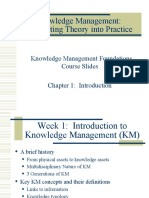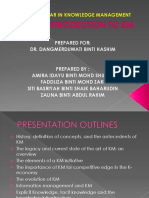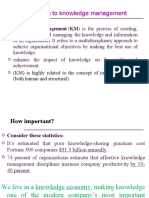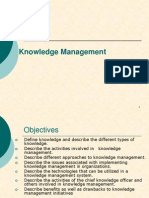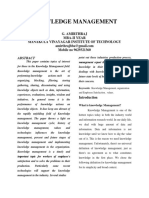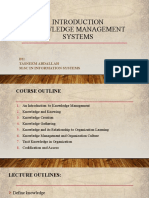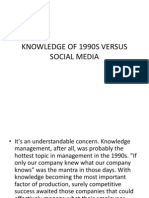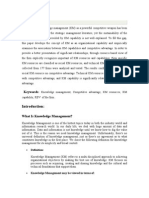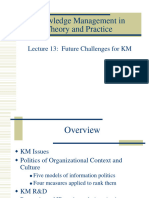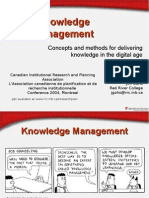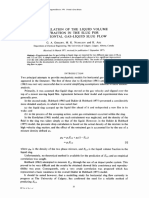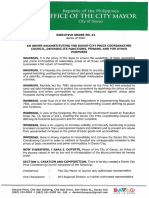History of Knowledge Management
The 1970’s
growing importance of information and explicit knowledge as valuable assets of
organizations are noticeable during this period
focused on the “learning organization” and emphasis within the cultural dimension of
managing knowledge is observed (P. Senge)
KM’s growth and practices were examined and assessed thru their publications
due to volume of knowledge computer technology started to become part of the solution
in a variety of ways (AUGMENT and www)
The 1980’s
importance of knowledge as a competitive asset was already well-recognized during this
time, in particular - its expression in professional competence
most organizations still did not have the strategies and methods for managing knowledge
late 1980’s - artificial intelligence and expert systems gave rise to such concepts as
“knowledge acquisition”, “knowledge engineering” and “knowledge-based systems” and
other computer-based ontologies (leading to the growth of systems for managing
knowledge)
As more thinkers and scholars publish their work, the phrase “knowledge management”
formally became part of the lexicon of management – resulting to books published for this
specific matter.
The 1990’s
growing number of academics and consultants had started talking about knowledge
management as the new business practice; at the same time, a significant number of large
management consulting firms had begun in-house knowledge management activities and
programs
more articles on knowledge management began to appear in an increasing number of
business journals
“Brainpower” by Tom Stewart (1991 article in Fortune Magazine) solidify the introduction
of KM as a formal topic of discussion
1995 when knowledge management in its current form first received significant attention
among corporations and organizations
Reference:
Uriarte, F., Introduction to Knowledge Management (ASEAN Foundation) (2008)
� Mid-1990s, it became widely recognized that the competitive edge of some of the world’s
leading companies was for the most part due to the robust knowledge assets of those
companies (having KM as mainstream business objective)
At the same time, nurturing knowledge assets such as competencies, customer
relationships and innovations became a focus of attention of many corporations
KM groups were established - International Knowledge Management Network (IKMN/
Europe) and Knowledge Management Forum (USA)
late 1990’s - big businesses started implementing “knowledge management solutions” -
Knowledge management became a rage and came to be seen as a highly desirable
alternative to the failed Total Quality Management (TQM) and business process re-
engineering initiatives.
Generations of Knowledge Management
A. First Generation KM
early knowledge management initiatives met with only limited success – looks great on
paper but failed to deliver on application
for a while, it looked as if KM was destined to be confined to the “management fad
graveyard”
due to scrutiny - companies realized that it was not the concept of knowledge
management that was the problem as such, but rather the way that they had gone about
approaching it
dawn of the new millennium, knowledge management mysteriously vanished from the
agenda of the top corporations
Reasons of Confidence Loss with KM:
1. The hype associated with knowledge management was too much with
consultants and technology vendors making too much money on the latest
management fad.
2. Many corporations spent too much financial resources usually on
exotic technologies with little or no return on their investments.
3. Most published materials on knowledge management were
very conceptual and lack practical applications.
B. Second Generation KM
In the light of the many practical failures of first generation knowledge management
techniques theorists began to study and scrutinize more closely the ways by which
knowledge is created and shared
a link between learning theory and management started to develop and more organic
models began to replace hierarchical models of organizational structure
Reference:
Uriarte, F., Introduction to Knowledge Management (ASEAN Foundation) (2008)
� Due to previous failures companies have started to take a different approach to KM - In
this new approach the emphasis is more on people, behaviors and ways of working rather
than on the application of technology.
Skeptics who believed that KM was just a fad became minority.
The more popular view is that KM may not remain a distinct discipline but may become an
integral part of the way organizations work (This happened to TQM but its principles and
practices have become integral part of how organizations operate)
Reference:
Uriarte, F., Introduction to Knowledge Management (ASEAN Foundation) (2008)




